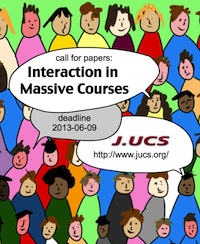Our scientific publication about Realfeedback titled “Developing a Web-Based Question-Driven Audience Response System Supporting BYOD” is now published as part of the Special J.UCS-Issue “Interaction in Massive Courses“.
Abstract:
Question-driven Audience Response Systems (ARSs) are in the focus of research since the 1960s. Since then, the technology has changed and therefore systems have evolved too. This work is about conception and implementation of the web-based ARS RealFeedback which uses the principle of bring your own device (BYOD). A state-of-the-art analysis compares the features of existing web-based ARSs. The most important findings are used for the conception and the implementation of the system. Thinking-aloud tests, and the first usages during lectures confirm that the chosen requirements are very significant and valuable for lecturers.
Reference: Haintz, C., Pichler, K., Ebner, M. (2014) Developing a Web-Based Question-Driven Audience Response System Supporting BYOD, Journal of Universal Computer Science (J.UCS). Special Issue on Interaction in Massive Courses. Bry, F., Ebner, M., Pohl, A., Taraghi, B. (Ed.) 20(1), p. 39-56

